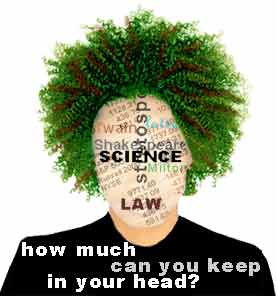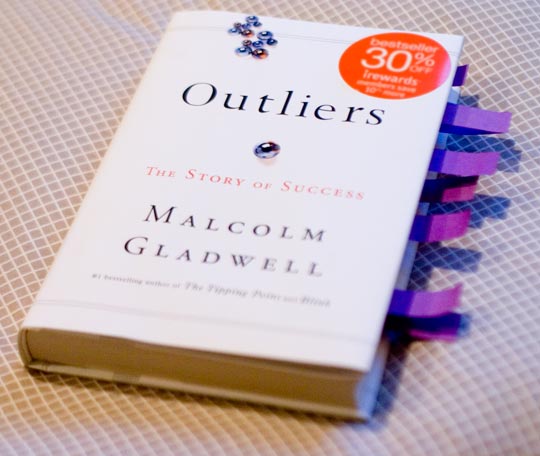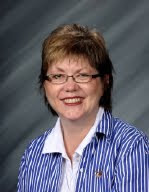Saturday, July 18, 2009
Wednesday, July 15, 2009
Information Overload

When sending someone a meeting request, phrase the subject and location so they make sense to all parties to the meeting. For instance, if Jill sends Jack a calendar item that says "Meeting with Jack - my office" it will be quite meaningless when viewed by Jack on his calendar. Always include both names and an absolute address - as in "Jack/Jill on budget proposal - Jill's office".
Excellent. This is clear, concise messaging. If you ever have to send me a 'meeting request,' you probably should know that my 'absolute address' is THE LIBRARY. By the way, did you know that Jack had a calendar? That piece of information had previously eluded me.
We all know that one website leads to another, and before I knew it, I arrived at Information Overload Killer, a site selling the solution to all my problems. With this product, I can do more than reduce information overload, I can kill it!
But first I decided to take their test to see if my money would be well-spent. Question One: Are you exasperated and at your wits end? Question Two: Are you frustrated? Question Three: Are you overwhelmed? Question Four: Are you ready to put your fist through the computer screen? yes, yes, yes, Yes!
Let me get my debit card. Scrolling down to the end of the screen, I was asked what I would expect to pay for my resurrected sanity -- $250? $175? $97? $52? Information this good is hard to come by--I'd spring for any or all of the above. The actual price? Just $10. WHAT? TEN BUCKS? You can't get valuable, extensive information for a pittance. Back to the virtual drawing board. CLICK! . . . . Thank goodness our students never experience this phenomenon!
Tuesday, July 7, 2009
Tolerance!

Unfortunately, many school environments provide little in the way of education and enlightenment on an issue affecting 5% —many sources say up to 10%--of our student body. Though acceptance of gay and lesbian students has improved, these students continue to be subjected to harassment that is both verbal and physical. The Gay, Lesbian and Straight Education Network (GLSEN) found that “9 out of 10 secondary school principals report that their students have been harassed.
If 90% of gay and lesbian students have reported being harassed in school, it is important to look at the outcomes of this abuse. Statistical evidence provides overwhelming insight into the suffering of gay and lesbian students. Consider the following statistics from Youth Pride, Inc. (2009):
· 36.5 % of GLB youth grades 9-12 have attempted suicide --20.5% of those attempts resulting in medical care.
· 84% of LGBT students report being verbally harassed (name calling, threats, etc.) because of their sexual orientation.
· 91.5% of LGBT students report hearing homophobic remarks, such as “faggot,” “dyke” or the expression “that’s so gay” frequently or often.
· 82.9% of LGBT students report that faculty or staff never intervened or intervened only some of the time when homophobic remarks were made.
These are only a few of the disturbing statistics related to gay teens.
They seem overwhelming; however, many schools are beginning to address the issue. One of the most encouraging changes is the growing number of Gay Straight Alliances in high schools and middle schools.
Of course, before we can implement these changes, we as educators must examine our own biases and prejudices. If we are truly committed to all of our students, we will strive to overcome any behavior that marginalizes any of our students. As we sensitize ourselves and educate ourselves, our ability to open up and embrace our students of diversity will increase. We can learn to stand beside all of our students, even those that are gay or lesbian and authentically advocate for their success in school as well as in life.
Tuesday, June 30, 2009
"Only the Educated Are Free" --Epictetus
"Eighty-five percent of all juveniles who interface with the juvenile court system are functionally illiterate. More than 60 percent of all prison inmates are functionally illiterate.Penal institution records show that inmates have a 16% chance of returning to prison if they receive literacy help, as opposed to 70% who receive no help.Illiteracy and crime are closely related. The Department of Justice states, 'The link between academic failure and delinquency, violence, and crime is welded to reading failure.' Over 70% of inmates in America's prisons cannot read above a fourth grade level."
The library was modest to say the least. There are no computers and there is no internet access in the prison. Many of the books were old and ragged, and Glen told us that they are always in need of more books and are happy to take donations. He said that especially during the winter months, the library is very busy.
After we left the prison, I was struck by the irony of the situation. Is there a need for prison libraries? Can we help by donating books and materials? The answer, of course, is yes. And yet, as we look at the literacy statistics of those who are incarcerated--60% are functionally illiterate, I couldn't help but wonder how many prisoners never use the library because of their inability to read.
Back on the bus, various conversations broke out about the prison experience. The general consensus? We were overwhelmed by the feeling that even as temporary volunteers we had to give up every basic freedom that we take for granted. But more importantly, we concluded that our mandate as educators is clear. We must work relentlessly, and intervene whenever necessary, to empower our students by giving them the precious gift of literacy.
If you would like to donate any books, used or new, just e-mail me, and I'll give the information you'll need to send the books to the prison.
Wednesday, June 24, 2009
The Literate American
A. Paul Revere's Ride
C. A domesticated bird is more valuable than birds in the wild.
1. B; 2. C; 3. B; 4. A; 5. B
Wednesday, June 17, 2009
Essential Questions

--Kermit, the Frog
Theodore Sizer, Dean of Brown University School of Education, conceived of the use of essential questions as a way to improve the knowledge and skills of high school students in his book Horace’s Compromise published in 1984. Using essential questions in teaching and learning has become one of the cornerstones of educational reform.
What do we mean by using essential questions? Jamie McKenzie, a proponent of educational reform and technology integration and the creator of the research model, the Research Cycle, says that “the question is the answer.” As editor of the online educational technology journal, From Now On, McKenzie says this:
"Essential questions reside at the top of Bloom's Taxonomy. They require
students to EVALUATE (make a thoughtful choice between options, with the choice based upon clearly stated criteria), to SYNTHESIZE (invent a new or different
version) or to ANALYZE (develop a thorough and complex understanding through
skillful questioning).Essential questions spark our curiosity and sense of
wonder. They derive from some deep wish to understand something which matters to us.”
How do you think the Puritans would incorporate technology into their lives?
What would the Puritans think of the powerful evangelical right’s
involvement in politics today?
From what you know, what would be the best
and the worst things about being a Puritan?These are examples of jumping off points that will lead to more questions and take our learning from a linear to a cyclical experience. Essential questions like these allow us to make connections to our own lives. If we pursue a study of this kind, we come to perceive Puritans as real human beings. Our understanding is deepened and spurs more curiosity.
Clifford and Friesen of the Galileo Educational Network point out that an essential question is “always poised at the boundary of the known and the unknown. It engages the imagination in significant ways. Attempts to answer an essential question open up mysteries that successively reveal themselves the more we come to ‘know’.”
Teaching and learning strategies that prompt us to become life-long learners who reach for insight and profound meaning, are worth the effort. As promoters of information literacy, librarians and teachers can help students use essential questions as higher order thinking skills that will result in meaningful, authentic learning.
Wednesday, June 10, 2009
Success and the Achievement Gap
 Would you believe that most Canadian hockey stars are born in January, February, or March? That Robert Oppenheimer, the head of the Manhattan Project, tried to poison one of his professors? Or, that Bill Gates credits much of his success to luck? These are just three of the intriguing stories of Malcolm Gladwell's new bestseller Outliers: The Story of Success.
Would you believe that most Canadian hockey stars are born in January, February, or March? That Robert Oppenheimer, the head of the Manhattan Project, tried to poison one of his professors? Or, that Bill Gates credits much of his success to luck? These are just three of the intriguing stories of Malcolm Gladwell's new bestseller Outliers: The Story of Success.Gladwell is convincing in his thesis, that success is much more than intelligence and hard work. He doesn't deny the importance of these attributes but identifies other variables like when, where, and how you were born. For example, in the junior Canadian hockey league, the cut-off age for moving from one level to the next is January 1st. A child born early in the year is going to be stronger and more mature than one born later. Because there are also levels within levels, the months-older, stronger players are moved up to a higher skill level within their age group. At higher skill levels, players learn better skills and so on and so on.
Why was Robert Oppenheimer chosen to head the Manhattan Project which produced the first atomic bomb? After all, 20 years earlier he tried to poison one of his professors. Gladwell says that because Oppenheimer was from a refined, elite family his abhorrent act was overlooked.
And what about Bill Gates? Another example of privilege. In 1968, Bill Gates was in the 8th grade when his elite private school purchased a computer. At a time when most colleges didn't have computers, Gates and his friends logged a lot of hours learning programming.
Gladwell also draws some conclusions about education in the United States. He believes that the length of our school year is one reason that American kids do so poorly in math when compared to other students. On a math test given around the world, twelfth-graders were asked how many of the questions covered material they had already learned. The Japanese said 92%. The American students said 54%. The Japanese go to school about sixty days more than Americans each year. Over a 12-year period, that's a lot more math.
Is summer vacation really too long? When it comes to the achievement gap between the "haves" and the "have-nots," Gladwell shares some startling statistics. The city of Baltimore began giving the California Achievement Test in reading not just at the end of each school year, but also in September when school begins. During the school year, the first through fifth graders on "free or reduced meals" scored and progressed equally with other students. However, when Baltimore begin testing again in the fall, the results were devastating. The poor kids had fallen behind by four points while the wealthiest kids test scores jumped 15 points. The difference--summer vacation. While the wealthiest kids were reading their own books, going to summer camps, etc., the poorer kids were spending boring days in front of the television.
What does this mean for us as educators? David Levin, the co-founder of the KIPP (Knowledge is Power Program) charter schools, believes that it means more school time for the disadvantaged. KIPP kids like Marita, a 5th grader in the South Bronx, go to school for ten hours a day, do two or more hours of homework a night, go to school some Saturdays as well as an extra month in the summer. The results--only 16% of kids in other South Bronx schools are performing at grade level in math. By the end of 8th grade, the KIPP kids are at 84%.
Applying Gladwell's findings to closing the achievement gap in education is far too simplistic, but the book can help us rethink and expand on ways to succeed in our attempts.
Wednesday, June 3, 2009
American Apartheid
In his book Ordinary Resurrections: Children in the Years of Hope (2000), educator and activist, Jonathan Kozol recalls the time that he spent in the Mott Haven section of South Bronx. The students were virtually all black and Hispanic. In the book, Kozol expresses a faint sense of hope rarely found in his works. He describes a school population where many students have asthma because of the inordinate number of garbage dumps in the area. Knowing someone with AIDS is common. In spite of a system that he labels an “apartheid education,” he praises the after-school program held at a neighborhood church.

Five years later, in the Harper’s article, “Still Separate, Still Unequal: America's Educational Apartheid,” he describes a return to hopelessness and an educational system that is taking a backward glance.
Kozol describes the physical environments that ignore the basic needs of students. Insufficient bathroom facilities, dirty halls and classrooms, and too few desks and tables barely fulfill the needs on the bottom rung of Maslow’s Hierarchy of Needs; physiological needs like thirst, hunger, and bodily comfort must be addressed before any other growth can take place.
Even if the basic needs were met in the schools that Kozol describes, it still would be far from making headway in the education of their children. The inequities in the budgets and salaries of the rich and poor schools of New York City are devastating. The bleak desperation of the school personnel, parents, and students in the poor districts can only be described as demoralizing.
The attitudes of the faculty and students in these schools seem only fitting for the situation. When Kozol interviewed students at MLK High School, one 16-year-old girl stated that “If people in New York woke up one day and learned that we had gone, had simply died or left for somewhere else . . . they would be relieved.”
Most of the students in my school would not share this feeling. However, I just can’t shake the notion that with all that we provide our kids, I have no doubt that we have students who feel just as hopeless and invisible as those in the article. I’m sure we have some students who believe that the school would be “relieved” if he or she just disappeared. Sadly enough, in some cases, they would be right.
The teachers described in the article seem to represent the attitudes of teachers everywhere. All schools have expert teachers that are passionate, resilient, and hopeful. Most schools also have teachers that are lazy, disconnected, unprepared, and out of their element. The extremes in teachers' attitudes are only magnified in Kozol's schools.
Thursday, May 28, 2009
No Walls

I titled this blog "Beyond Bindings" because it describes the changing status of school library media centers today. It is one of the most exciting evolutions happening in education. The library media center has morphed into a center for acquiring information in myriad forms. Today's library media specialist can now hold the key to a world beyond the walls of the library.
However, before we look further into the current changes, let's go back a bit to a time when a specific technological event brought about the first sea change in school libraries. In 1957 the Soviet Union surprised the world when it launched a little satellite called "Sputnik." Of course, not to be outdone, the United States recognized the challenge, accepted it, and the space race was off and running. First, we needed to prepare our best and brightest for success in orbit. Money was infused into our public schools to update our library collections to educate the future scientists that would take us to the moon and beyond. Check any school library's collection that has not been properly weeded, and you will find a remarkable number of titles from the 1960s.
Outer space is fine, but the 21st-century school library exposes us to a boundless digital world. Online databases provide students with limitless sources for research. With inter-library loan, hard copies, e-books, movies, music, and other resources are available to serve the individual needs of our students.
Perhaps one of the most dynamic changes is the phenomenon known as Library 2.0. Like Web 2.0, Library 2.0 moves us from a passive use of the internet into an interactive environment. Wikis, blogs, podcasts, You Tube, and digital stories are some of the products that result when we use 2.0 technology. Using these 2.0 tools can bring a whole new meaning to authentic learning. Using these tools for their ultimate purpose, requires critical thinking and creativity. Students write with a sense of immediacy for a real audience. Using these tools can help our students move up Bloom's pyramid. Students learn to question, and create new knowledge.
The 21st-century library media center goes way beyond the bindings of books on the library shelves. Today's library media specialist is the guide and facilitator through a vast digital world of limitless possibilities.
Check out this link about Library 2.0
http://library20.ning.com/


